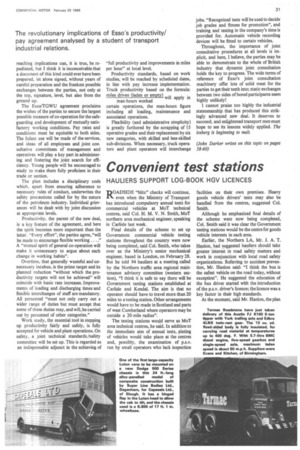Convenient test stations
Page 33

Page 34

If you've noticed an error in this article please click here to report it so we can fix it.
HAULIERS SUPPORT LOG-BOOK HGV LICENCES DOAD S IDE "blitz" checks will continue, 1-■ even when the Ministry of Transport has introduced compulsory annual tests for commercial vehicles at MoT technical centres, said Col. H. M. V. N. Smith, MoT northern area mechanical engineer, speaking in Carlisle last week.
Final details of the scheme to set up Government commercial vehicle testing stations throughout the country were now being completed, said Col. Smith, who takes over as the Ministry's senior mechanical engineer, based in London, on February 28. But he told 94 hauliers at a meeting called by the Northern traffic area regional maintenance advisory committee (western section), "I think it is safe to say there will be Government testing stations established at Carlisle and Kendal. The aim is that no operator should have to travel more than 20 miles to a testing station. Other arrangements would have to be made in Scotland and parts of west Cumberland where operators may be outside a 20-mile radius".
The testing stations would serve as MoT area technical centres, he said. In addition to the immediate aim of annual tests, plating of vehicles would take place at the centres and, possibly, the examination of p.s.v. run by small operators who lack inspection facilities on their own premises. Heavy goods vehicle drivers' tests may also be handled from the centres, suggested Col. Smith.
Although he emphasized final details of the scheme were now being completed, Col. Smith said it was clear the Government testing stations would be the centre for goods vehicle interests in each area.
Earlier, the Northern LA, Mr. J. A. T. Hanlon, had suggested hauliers should take greater interest in road safety matters and work in conjunction with local road safety organizations. Referring to accident prevention, Mr. Hanlon said: "I think the bus is the safest vehicle on the road today, without exception". He suggested the education of the bus driver started with the introduction of the p.s.v. driver's licence; the licence was a key factor in their high standards.
At the moment, said Mr. Hanlon, the plan was for the h.g.v. licence to be purely a driving licence—it would not be possible for it to be taken away, except for driving offences, unlike the p.s.v. licence, which could be taken away if the holder were found guilty of bad behaviour.
Several present, including former merchant seaman Mr. J. Dent, of Joe Dent and Co., Carlisle, spoke in support of a suggestion by Mr. N. T. O'Reilly, of Robsons Border Transport, that the licence should be like a merchant seaman's passbook. Mr. O'Reilly pleaded that the Ministry should make it a worthwhile document which would mean something to the industry and to the man in the street. It should give the owner's life story in addition to proof of his ability in his career. "Some 98.5 per cent of our drivers are worth such a certificate," he said, and added that it would prove a great asset in the matter of vehicle security.
Mr. Hanlon asked if these views irere the general opinion of those present and the proposal was greeted with approval.
Chairman of the meeting, Mr. H. Pickth all, of J. A. Pickthall and Sons, of Cleator Moor, challenged Mr. Hanlon's statement on safe driving. "I think if we commercial vehicle operators got down to the safe driving awards, we would surpass the achievement of bus drivers," he said.
Mr. C. E. Humphrey succeeds Col. Smith as Northern area mechanical engineer, on February 28.




























































































































